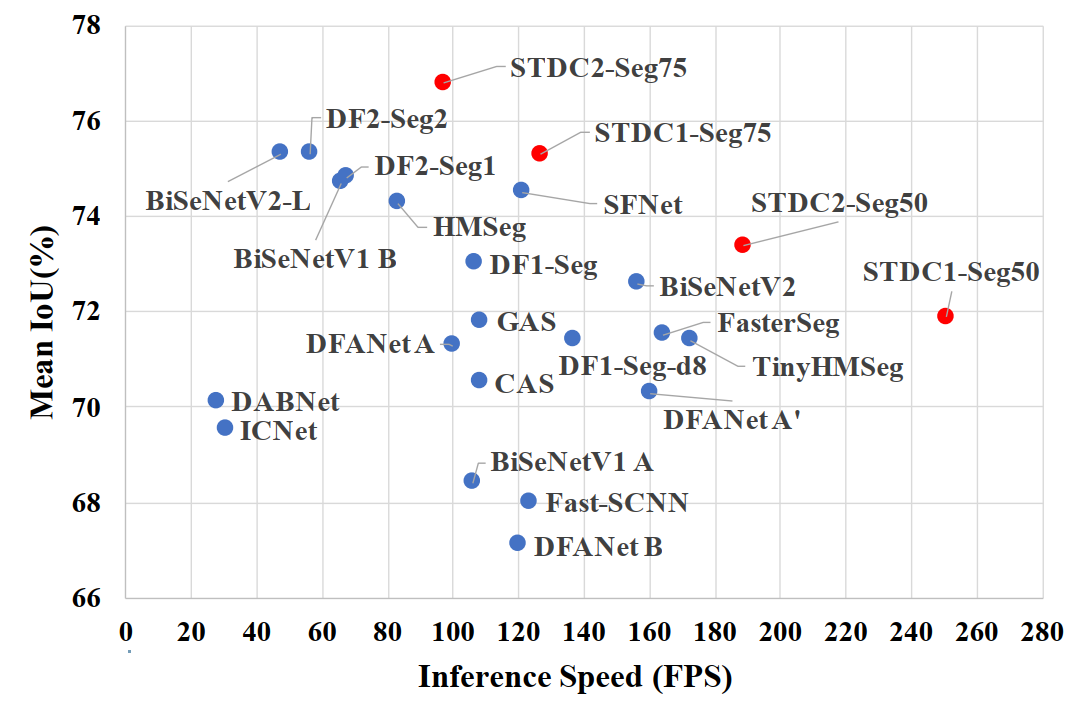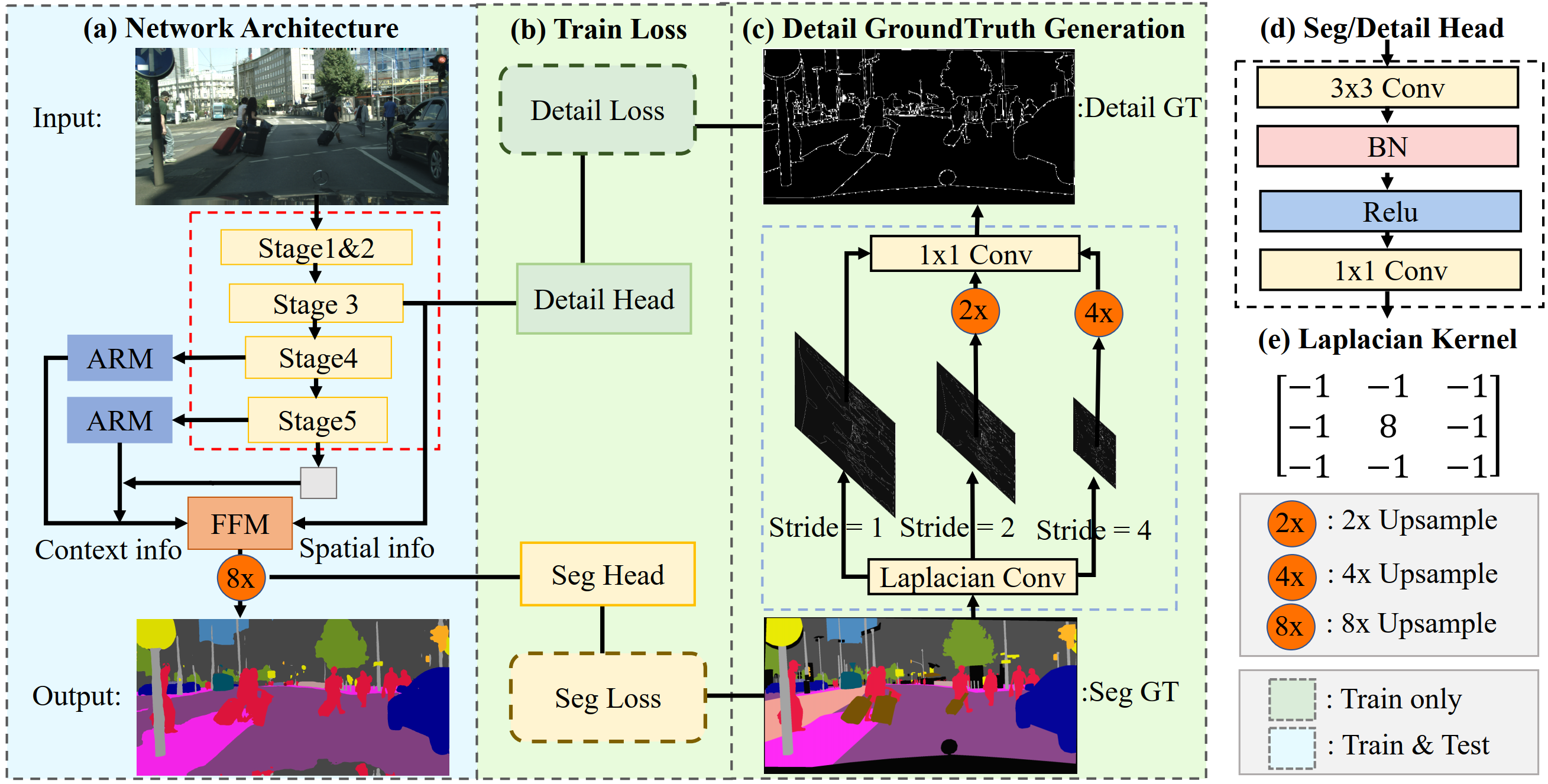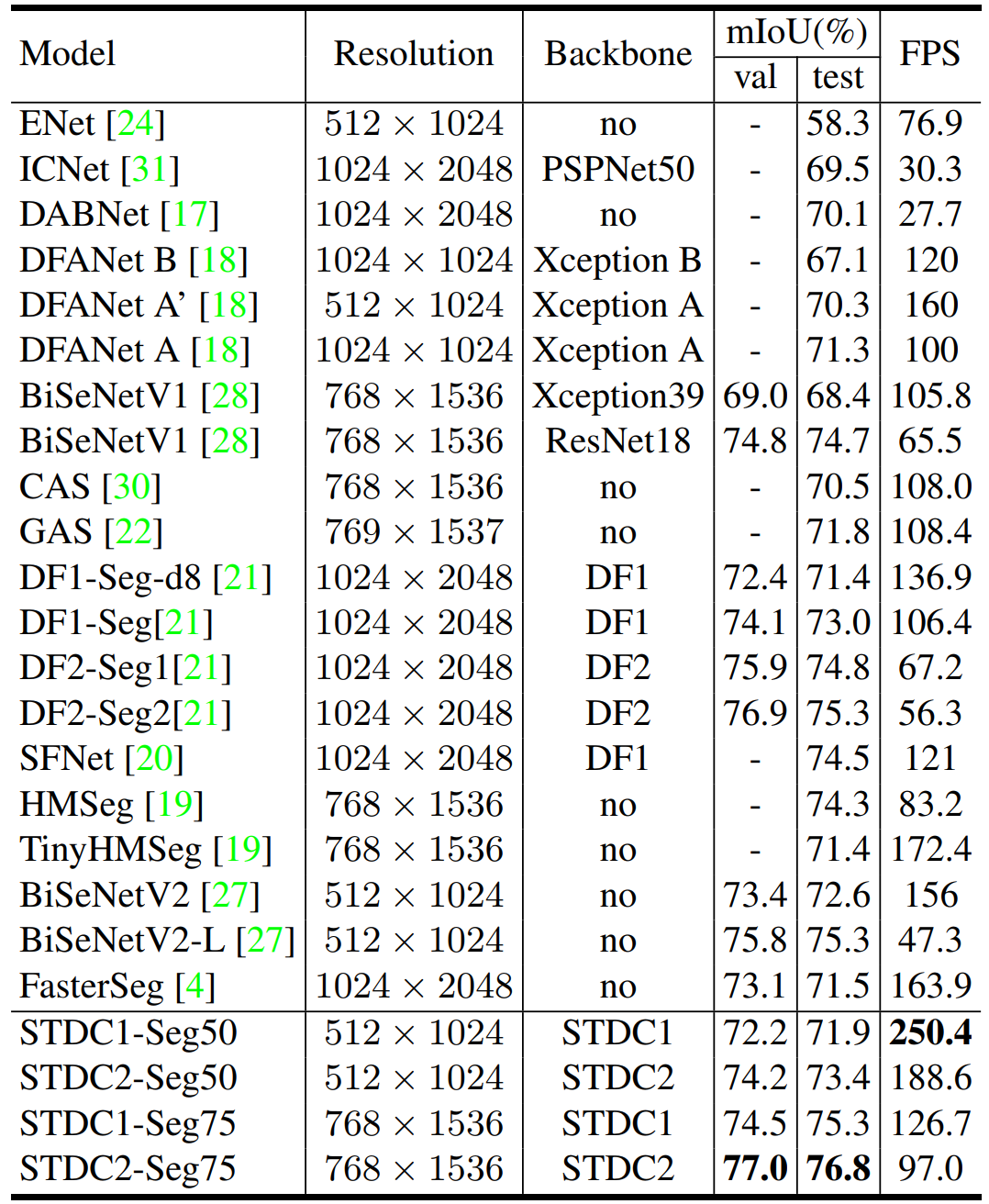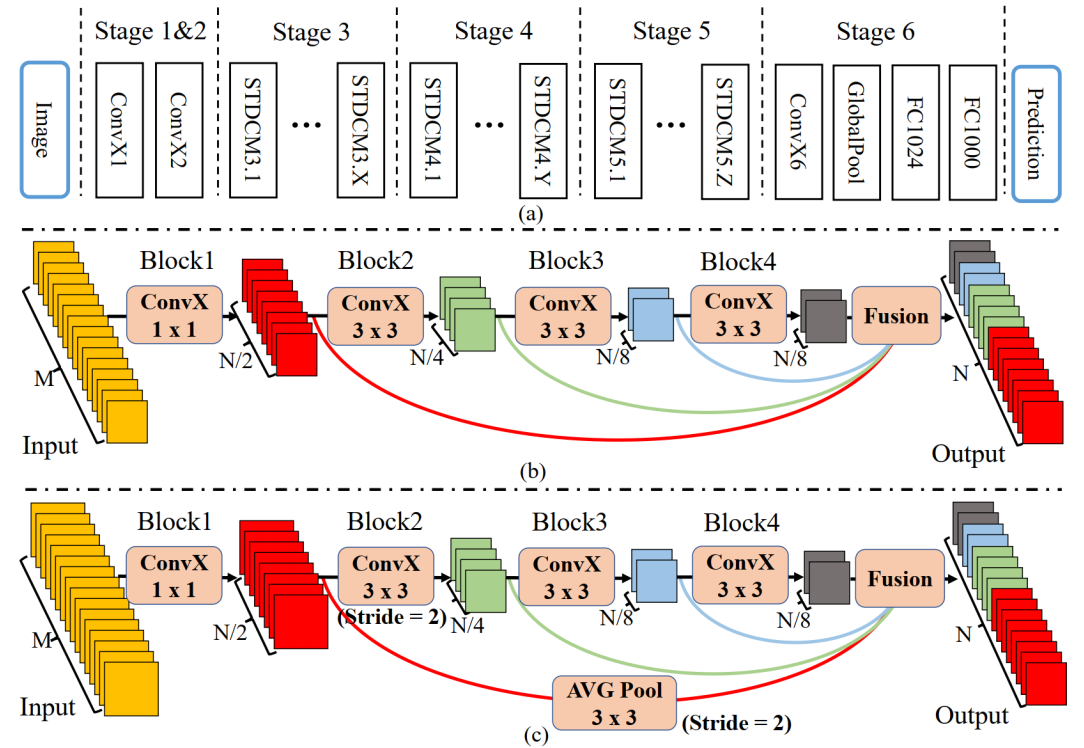Rethinking BiSeNet For Real-time Semantic Segmentation[PDF]
Mingyuan Fan, Shenqi Lai, Junshi Huang, Xiaoming Wei, Zhenhua Chai, Junfeng Luo, Xiaolin Wei
In CVPR 2021.

Speed-Accuracy performance comparison on the Cityscapes test set
Highlights:
- Short-Term Dense Concatenation Net: A task-specific network for dense prediction task.
- Detail Guidance: encode spatial information without harming inference speed.
- SOTA: STDC-Seg achieves extremely fast speed (over 45% faster than the closest automatically designed competitor on CityScapes) and maintains competitive accuracy.
- see our Cityscapes test set submission STDC1-Seg50 STDC1-Seg75 STDC2-Seg50 STDC2-Seg75.
- Here is our speed-accuracy comparison on Cityscapes test&val set.

Overview of the STDC Segmentation network
- Pytorch 1.1
- Python 3.5.6
- NVIDIA GPU
- TensorRT v5.1.5.0 (Only need for testing inference speed)
This repository has been trained on Tesla V100. Configurations (e.g batch size, image patch size) may need to be changed on different platforms. Also, for fair competition, we test the inference speed on NVIDIA GTX 1080Ti.
- Clone this repo:
git clone https://github.com/MichaelFan01/STDC-Seg.git
cd STDC-Seg- Install dependencies:
pip install -r requirements.txt- Install PyCuda which is a dependency of TensorRT.
- Install TensorRT (v5.1.5.0): a library for high performance inference on NVIDIA GPUs with Python API.
-
Download the leftImg8bit_trainvaltest.zip and gtFine_trainvaltest.zip from the Cityscapes.
-
Link data to the
datadir.ln -s /path_to_data/cityscapes/gtFine data/gtFine ln -s /path_to_data/leftImg8bit data/leftImg8bit
Note: Backbone STDCNet813 denotes STDC1, STDCNet1446 denotes STDC2.
- Train STDC1Seg:
export CUDA_VISIBLE_DEVICES=0,1,2
python -m torch.distributed.launch \
--nproc_per_node=3 train.py \
--respath checkpoints/train_STDC1-Seg/ \
--backbone STDCNet813 \
--mode train \
--n_workers_train 12 \
--n_workers_val 1 \
--max_iter 60000 \
--use_boundary_8 True \
--pretrain_path checkpoints/STDCNet813M_73.91.tar- Train STDC2Seg:
export CUDA_VISIBLE_DEVICES=0,1,2
python -m torch.distributed.launch \
--nproc_per_node=3 train.py \
--respath checkpoints/train_STDC2-Seg/ \
--backbone STDCNet1446 \
--mode train \
--n_workers_train 12 \
--n_workers_val 1 \
--max_iter 60000 \
--use_boundary_8 True \
--pretrain_path checkpoints/STDCNet1446_76.47.tarWe will save the model's params in model_maxmIOU50.pth for input resolution 512x1024,and model_maxmIOU75.pth for input resolution 768 x 1536.
ImageNet Pretrained STDCNet Weights for training and Cityscapes trained STDC-Seg weights for evaluation:
BaiduYun Link: https://pan.baidu.com/s/1OdMsuQSSiK1EyNs6_KiFIw Password: q7dt
GoogleDrive Link:https://drive.google.com/drive/folders/1wROFwRt8qWHD4jSo8Zu1gp1d6oYJ3ns1?usp=sharing
Here we use our pretrained STDCSeg as an example for the evaluation.
- Choose the evaluation model in evaluation.py:
#STDC1-Seg50 mIoU 0.7222
evaluatev0('./checkpoints/STDC1-Seg/model_maxmIOU50.pth', dspth='./data', backbone='STDCNet813', scale=0.5,
use_boundary_2=False, use_boundary_4=False, use_boundary_8=True, use_boundary_16=False)
#STDC1-Seg75 mIoU 0.7450
evaluatev0('./checkpoints/STDC1-Seg/model_maxmIOU75.pth', dspth='./data', backbone='STDCNet813', scale=0.75,
use_boundary_2=False, use_boundary_4=False, use_boundary_8=True, use_boundary_16=False)
#STDC2-Seg50 mIoU 0.7424
evaluatev0('./checkpoints/STDC2-Seg/model_maxmIOU50.pth', dspth='./data', backbone='STDCNet1446', scale=0.5,
use_boundary_2=False, use_boundary_4=False, use_boundary_8=True, use_boundary_16=False)
#STDC2-Seg75 mIoU 0.7704
evaluatev0('./checkpoints/STDC2-Seg/model_maxmIOU75.pth', dspth='./data', backbone='STDCNet1446', scale=0.75,
use_boundary_2=False, use_boundary_4=False, use_boundary_8=True, use_boundary_16=False)- Start the evaluation process:
CUDA_VISIBLE_DEVICES=0 python evaluation.py- If you have successfully installed TensorRT, you will automatically use TensorRT for the following latency tests (see function here).
- Otherwise you will be switched to use Pytorch for the latency tests (see function here).
- Choose the evaluation model in run_latency:
# STDC1Seg-50 250.4FPS on NVIDIA GTX 1080Ti
backbone = 'STDCNet813'
methodName = 'STDC1-Seg'
inputSize = 512
inputScale = 50
inputDimension = (1, 3, 512, 1024)
# STDC1Seg-75 126.7FPS on NVIDIA GTX 1080Ti
backbone = 'STDCNet813'
methodName = 'STDC1-Seg'
inputSize = 768
inputScale = 75
inputDimension = (1, 3, 768, 1536)
# STDC2Seg-50 188.6FPS on NVIDIA GTX 1080Ti
backbone = 'STDCNet1446'
methodName = 'STDC2-Seg'
inputSize = 512
inputScale = 50
inputDimension = (1, 3, 512, 1024)
# STDC2Seg-75 97.0FPS on NVIDIA GTX 1080Ti
backbone = 'STDCNet1446'
methodName = 'STDC2-Seg'
inputSize = 768
inputScale = 75
inputDimension = (1, 3, 768, 1536)- Run the script:
CUDA_VISIBLE_DEVICES=0 python run_latency.py@InProceedings{Fan_2021_CVPR,
author = {Fan, Mingyuan and Lai, Shenqi and Huang, Junshi and Wei, Xiaoming and Chai, Zhenhua and Luo, Junfeng and Wei, Xiaolin},
title = {Rethinking BiSeNet for Real-Time Semantic Segmentation},
booktitle = {Proceedings of the IEEE/CVF Conference on Computer Vision and Pattern Recognition (CVPR)},
month = {June},
year = {2021},
pages = {9716-9725}
}
- Segmentation training and evaluation code from BiSeNet.
- Latency measurement from the Faster-Seg.


